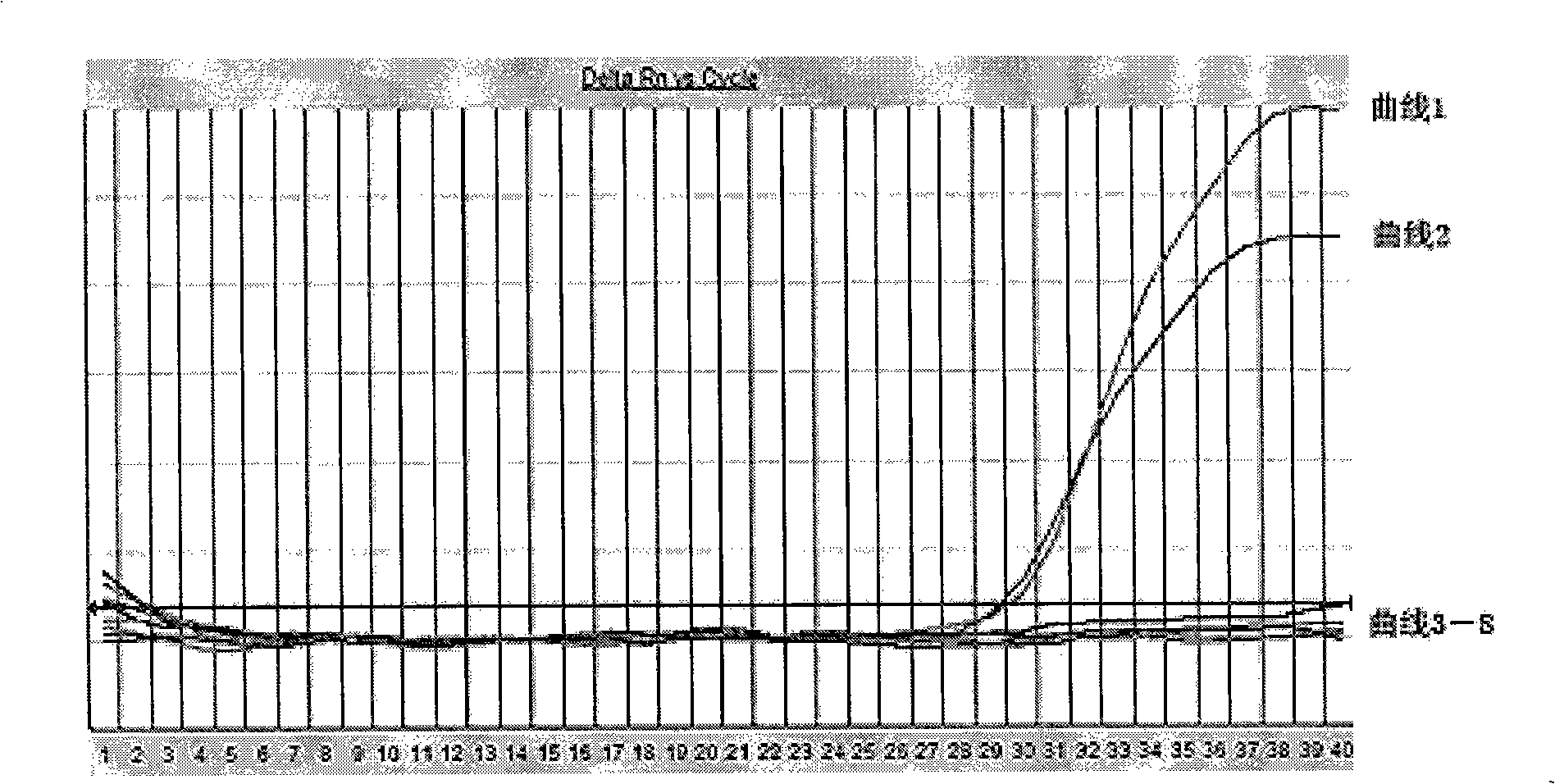Probe, primer and reagent kit for realtime fluorescent quantitative RT-PCR detection of classical swine fever virus
A real-time fluorescence quantitative, swine fever virus technology, applied in the determination/inspection of microorganisms, biochemical equipment and methods, DNA/RNA fragments, etc. Simple, fast detection effect
- Summary
- Abstract
- Description
- Claims
- Application Information
AI Technical Summary
Problems solved by technology
Method used
Image
Examples
Embodiment 1
[0073] Positive control: Viral RNA was extracted from the attenuated swine fever rabbit vaccine.
[0074] Negative control: Use non-infected CSFV porcine tissue, add DEPC water at a volume of 1:10, grind in a tissue homogenizer, centrifuge at 3500 rpm for 15 min, and take the supernatant to extract sample RNA.
[0075] reaction system:
[0076] 5×buffer 5.0μl
[0077] 25mmol / L MgCl 2 2.0μl
[0078] RNase Inhibitor 0.5μl
[0079] Reverse Transcriptase 0.2μl
[0080] 10mmol / L dNTPs 0.5μl
[0081] 10μmol / L Primer 1 0.5μl
[0082] 10μmol / L Primer 2 0.5μl
[0083] 10μmol / L Probe 0.5μl
[0084] Taq enzyme 0.5μl (3U / μl)
[0085] RNA 5.0μl
[0086] DEPC H 2 O 9.8 μl
[0087]
[0088] 25 μl total
[0089] Reaction conditions: the first stage, reverse transcription 45°C / 15min;
[0090] In the second stage, pre-denaturation at 95°C / 5min;
[0091] In the third stage, 94°C / 30s, 58°C / 45s, 40 cycles. Fluorescent signal is detected upon ...
Embodiment 2
[0093] Embodiment 2 specificity research
[0094]In view of the high homology of the genome sequences of BVDV, BDV, and CSFV of the genus Pestivirus in the family Flaviviridae, and the widespread occurrence of animal virus infections such as PRRSV, PRV, PPV, and PCV-2 in intensive pig farms in my country, and These epidemics have certain similarities in epidemiology, clinical symptoms, pathological manifestations, and histological changes of affected animals. Therefore, the present invention adopts CSFV, BVDV, BDV, PRRSV, PRV, PPV, PCV-2 and other virus culture Liquid for comparative study to determine the specificity of the method of the present invention.
[0095] The experimental results can be found in the attached figure 2 , the two positive "S" curves represent the results of real-time RT-PCR amplification using RNA extracted from 20 μl and 10 μl CSFV culture medium as templates, while the other six viral RNAs did not amplify "S" Curve, no Ct value, the experimental res...
Embodiment 3
[0097] The comparative study of different detection methods of embodiment 3
[0098] Using RT-PCR, real-time RT-PCR and AC-ELISA three different detection methods to detect the same sample, and compare the detection results to determine the sensitivity of the method. 268 clinical tissue samples, 324 clinical blood samples, 122 salted sausage casings, 96 meat cuts, and 24 cured meat samples were tested.
[0099] The molecular biology detection method is: homogenate the tested sample, dilute it with sterilized physiological saline according to the ratio of 1:4, 1:8, 1:16, 1:32, 1:64, and extract the total RNA of the sample , and then perform CSFV RT-PCR and real-time RT-PCR detection according to the method designed in this study, instead of taking samples to extract RNA, diluting the RNA and then conducting sensitivity research, which is different from the detection required in real work The samples are basically the same; for the AC-ELISA detection method, the diluted homogen...
PUM
 Login to View More
Login to View More Abstract
Description
Claims
Application Information
 Login to View More
Login to View More - R&D
- Intellectual Property
- Life Sciences
- Materials
- Tech Scout
- Unparalleled Data Quality
- Higher Quality Content
- 60% Fewer Hallucinations
Browse by: Latest US Patents, China's latest patents, Technical Efficacy Thesaurus, Application Domain, Technology Topic, Popular Technical Reports.
© 2025 PatSnap. All rights reserved.Legal|Privacy policy|Modern Slavery Act Transparency Statement|Sitemap|About US| Contact US: help@patsnap.com



